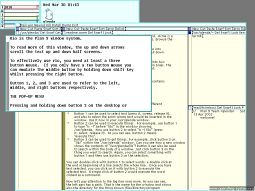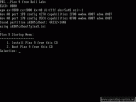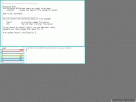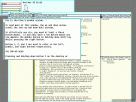536 words [ 5 Screenshots ] [ 5 Versions ] [ 2 Weblinks ] - Last update: 2023-12-22 Page created: 2004-04-03 [SB]
Plan 9
 Plan 9 was developed into the AT&T Bell Laboratories since 1985. In 1989 it had achieved the stability to replace UNIX into the Bell Labs. Ken Thompson which had played a part years before in the development of UNIX also worked on this project. With project 9 the disadvantages of Unix should be eliminated and put a new measure of accuracy, economy and efficiency. Normal microcomputers serve as hardware base. It was programmed in strict ISO/ANSI C. Plan 9 was ported for the Intel 386 (or higher), MIPS, Alpha, and PowerPC architecture. This operating system is not designed for the end-user, it shows new design concepts and technologies and disposed of very few drivers, commercial applications are missing.
Plan 9 was developed into the AT&T Bell Laboratories since 1985. In 1989 it had achieved the stability to replace UNIX into the Bell Labs. Ken Thompson which had played a part years before in the development of UNIX also worked on this project. With project 9 the disadvantages of Unix should be eliminated and put a new measure of accuracy, economy and efficiency. Normal microcomputers serve as hardware base. It was programmed in strict ISO/ANSI C. Plan 9 was ported for the Intel 386 (or higher), MIPS, Alpha, and PowerPC architecture. This operating system is not designed for the end-user, it shows new design concepts and technologies and disposed of very few drivers, commercial applications are missing.
The concept intends to delegate functions on the computers in the network efficiently. Like this it is possible to mirror processes on other computers to provide fault tolerance at failed systems. Office tasks are solved so on modest terminals, the resources for this come from a central server in the network. Even the subdivision can go so far that a server for the file sharing (FileStorage), one for the printers, one for applications and one is delegated for the computer performance (Computing Power).
Plan9 is a progressive multi-user operating system which is developed further as open source and does not build up on UNIX source code. It is optimized for the use in networks and is suitable for particularly all sorts of hardware platforms in distributed networks. By the isolation of the services on different servers a higher accuracy is given opposite to all-in-one solutions. The store of files on a File server is possible but not the execute of possible harming programs.
The Plan 9 Logo represents a rabbit which was drawn by Renée French. The name was elected from the science fiction movie "Plan 9 From Outer Space".
In Plan 9 useful schemes were taken by UNIX. This includes the organisation of the file system and the access to devices within the file structure. The file system and connection protocol "9 P" makes the access to resources of other computer systems possible. User defined views of the resource structure (Name Space) are possible. Project 9 got new compilers, library files (Libraries) and applications programmed. Older UNIX tools are or completely new programmed or has been omitted. Followed the bash Shell, Rc is used as specified command line interpreter. The portability as well as the file and access rights from Unix were revised and taken in project 9. One of the special abilities from the GUI 8 1/2 is a provided text-based and graphical interface for the local and remote login. Rio is the window manager. Plan9 is multi-processor capable, accelerated graphic rendering is not possible.
You can download Plan 9 from the Plan 9 website of Bell Labs after the accept of the licence as an 60 mbyte file archive together with a special boot disk. The disadvantage of Plan 9 is the limited hardware support. Project 9 is a trademark of Lucent Technologies, a subsidiary enterprise of AT&T. The development department of plan 9 was dissolved by Bell Labs in October 2005. The company Vita Nuova used in Inferno the 9P protocol.
Date - Version
1990 - Plan9 beta1993 - Plan 9 v1, not a public release1995 - Plan 9 v22000 June - Plan 9 v3 Edition (brazil) Kernel optimized2002 April - Plan 9 v4 Edition




